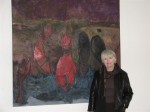Rashomon
Rashomon
Japan, 1950, 88 min, Japanese with English subtitles
Wednesday, Sept. 30, 7:15 pm, North Shore Cinema
Saturday, Oct. 3, Noon, Oriental Theatre
I’m not going to bore you with the “what is truth?” question, but well, from where I sit, the quest for it courses through Rashomon, a star in the vast universe known as the Milwaukee Film Festival.
As a lover of fairytales, I ask that you trust what I write, though perhaps my very words lie, and the cinema itself is a pack of untruths. I’ve seen this film perhaps six times in the past two decades, and frankly my dears, I don’t give a damn about who raped, or who murdered. It’s the tale I lust for: the tumble into and down the hole, the cloud shapes, the drumbeats, the voice from beyond the grave. Could be, it’s the fear of truth that so fascinates.
Bring it on — from the opening scene framed in the remnants of a noir-ish rain-lashed temple in Kyoto (the ancient capital of Japan transformed into Rashomon, a small fishing village) to the “neatly packaged fortune-cookie ending,” which, sorry, is jarringly wrong.
As in all great literature, you will find the magic No. 3 woven into the film, specifically in the trio of men (priest, commoner, woodcutter), who re-tell the tale. Fittingly, it is the woodcutter (a frequent character in many fairytales), who leads us into Director Akira Kurosawa’s landscape of possibilities, those shadowy glades where erotic delights and devastating destruction lurk. Quentin Tarantino has trod here, along with the likes of Stephen King, the Brothers Grimm and Hans Christian Andersen. It’s clear to me that Federico Fellini and Yukio Mishima and writers Oates and Mailer were influenced by Rashomon.
A struggle, a seduction …. a rape occurs, or is it a rape, for the lady’s eyes roll heavenward, either in ecstasy or despair? Kurosawa scatters clues, but like the Puck-ish Mifune, they slip ever-deeper into the forest.
Three ensnared in the glade. Will destiny, luck or death free them? Enchantment is a snarl of brambles, is it not? The cone-shaped hat draped in white veiling, worn by the Princess (the woman, the whore, the pure?), the trampled hat of the samurai (the noble, the brave, the treacherous?), the amulet of red (it re-appears later in the film). Slices of blinding sunlight, barely glimpsed bare through the tops of the canopied forest, suggest the all-seeing eye, but whose eye? God’s, Kurosawa’s, the audience watching this film?
Once-upon-a-time I sat ramrod-straight in an Iowa Methodist church, believing the stern Reverend B. as he preached hellfire and brimstone and spoke of streets paved gold with jasper inlay. I heard him tell of the multiplication of fish and loaves and how a man could die and be risen. I learned of a conception immaculate. As a college freshman embracing the printed words in my American History textbook, I was stunned numb when my professor shouted (and all heads turned toward me), “Miss Moriarty, do you always believe everything you read?!” I answered, “Yes.” And, he thundered, “Never ever believe everything you read.”
A reminder or two: Though Rashomon was set in civil-war Japan, it was filmed following WWII, when Japan was recovering from an apocalypse of devastation. This would explain the upbeat Westernized ending (hope for the future; life renewed), and it is certainly worth noting that Kyoto was actually removed from the list of cities targeted by the Atom bomb. It escaped with minimal damage and prospered to become the center of Japan’s television and film industry …. and the headquarters for Ninetendo.
And these final thoughts from my Rashomon experience …
And I don’t remember how I left the woods.
I don’t care if it’s a lie as long as I’m entertained.
Maybe goodness is just make-believe.
And my personal favorite …. In the end, you cannot understand the things men do.
What did you think about the ending? Did it suit the rest of the film?
Movies
-
Milwaukee Film Festival Returns in April
 Mar 27th, 2024 by Sophie Bolich
Mar 27th, 2024 by Sophie Bolich
-
Nina Simone’s Summer of Soul
 Nov 29th, 2022 by John Sieger
Nov 29th, 2022 by John Sieger
-
The Surprise Pick for Best Picture
 Mar 22nd, 2022 by Dominique Paul Noth
Mar 22nd, 2022 by Dominique Paul Noth
Theater
-
New Musical a Life and Death Comedy
![Stephanie Beschta [Mrs. McCobb] and Shayne Patrick [Mr. McCobb] in RIP – A Matter of Life and Death. Photo by Stacy Kaat (www.stacykaat.com).](https://urbanmilwaukee.com/wp-content/uploads/2024/07/WEB-6056-185x122.jpg) Jul 19th, 2024 by Dominique Paul Noth
Jul 19th, 2024 by Dominique Paul Noth
-
‘The Treasurer’ a Darkly Funny Family Play
 Apr 29th, 2024 by Dominique Paul Noth
Apr 29th, 2024 by Dominique Paul Noth
-
Rep’s Nina Simone Play a Puzzle
 Apr 23rd, 2024 by Dominique Paul Noth
Apr 23rd, 2024 by Dominique Paul Noth























A really great commentary on this particular film, and an even better commentary on the nature of perception – and the multi-experiences achieved within a single event. Perhaps it is not the ending that matters after all, but the pathway taken. Hurray for the likes of Kurosawa and those entertainers who drop a trail of crumbs to bring us to the hole in the hedge!